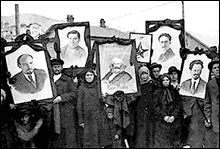Russian Revolution: The Origins of Discontent

Origins of discontent
 Siberian peasants in a Bolshevik celebration display placards of (left to right) Lenin, Sukhanoff, Marx Lumacarsky, and Trotsky. Related Links |
On November 7, Russians celebrate the anniversary of the violent upheaval that overthrew the czarist government in 1917. What forces toppled the centuries-old monarchy, and how did they set the stage for the Communist empire of the USSR? And why on earth is the October Revolution observed in November?
The revolution was the culmination of a long period of repression and unrest. From the time of Peter I (Peter the Great), the czardom increasingly became an autocratic bureaucracy that imposed its will on the people by force, with wanton disregard for human life and liberty. As Western technology was adopted by the czars, Western humanitarian ideals were acquired by a group of educated Russians. Among this growing intelligentsia, the majority of whom were abstractly humanitarian and democratic, there were also those who were politically radical and even revolutionary. The university became a seat of revolutionary activity; nihilism, anarchism, and later Marxism were espoused and propagated.
The reforms of Alexander II brought the emancipation of the serfs (1861; see Emancipation, Edict of) and opened the way for industrial development. However, emancipation imposed harsh economic conditions on the peasants and did not satisfy their need for farmland. Industrialization concentrated people in urban centers, where the exploited working class was a receptive audience for radical ideas. A reactionary and often ignorant clergy kept religion static and persecuted religious dissenters. Pogroms were instituted against the Jews, which turned many radical Jews to Zionism. Non-Russian nationalities in the empire were repressed.
By 1903, Russia was divided into several political groups. The autocracy was upheld by the landed nobility and the higher clergy; the capitalists desired a constitutional monarchy; the liberal bourgeoisie made up the bulk of the group that later became the Constitutional Democratic party; peasants and intelligentsia were incorporated into the Socialist Revolutionary party; and the workers, influenced by Marxism, were represented in the Bolshevik and Menshevik wings of the Social Democratic Labor party (see Bolshevism and Menshevism).
The Columbia Encyclopedia, Fifth Edition Copyright 1993, Columbia University Press. Licensed from Inso Corporation. All rights reserved.







